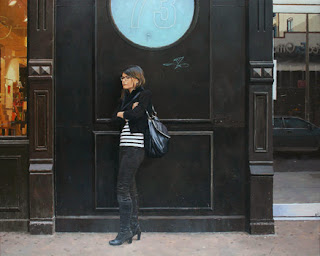Max Ferguson
Hyperrealism, Photorealism or Superrealism (call it what you will) is a resilient trend in contemporary art, which started, in part, as a response to various art movements of the mid-century and 1960s. Superrealists wanted to assert (yet again) that there was still value in representing the perceived world as it might be captured at one moment in one place. The difference, however, between superrealism and the realism of Courbet, for instance, would seem to involve the existence of the camera. Instead of responding to the camera (as other movements did) with contemptuous attempts to do what the camera could not, the superrealists abandoned all pretenses and candidly admitted that the camera and photography does, indeed, exist and that photography can be a legitimate aid or even a starting point in the process of painting.
Max Ferguson
A point many people seem to miss, however, is that neither realism nor superrealism is really 'realistic.' How, for instance, do we really know a given painting is an exact duplicate of a ‘real’ situation or a ‘real’ photo of a situation? How do we know that what is represented on the canvas really does exist somewhere? Actually, we don't and that's probably not the point anyway. Despite the meticulously detailed style of a superrealist painting, there is, in fact, no real assurance of a correspondence between the painted image and ‘reality.’ What if, for example, a superrealist decided to paint stuff that was never photographed or which never even existed? It could still be classified as superrealism. Realism and superrealism seem to refer to technique and not to any claims to be accurately representing something that happened or exists in the world.
There is, however, a huge difference between realism and superrealism. The key point would seem to be that in many superrealist paintings, the painter deliberately removes him/herself from the direct experience with ‘reality' that the realist painter often implies. He/she often starts with a photographic representation of reality and works to make this representation appear ‘superreal’ on a canvas. Conceivably, a superrealist work does not even have to correspond to a 'real' image. Surrealism did not have to correspond to real dream images and superrealism does not have to correspond to real, substantial world images. In fact, in this group show, we see how artsists painting in a superrealist tradition often tweak 'reality' to make it superreality.
Max Ferguson
Max Ferguson’s superrealist/photorealist paintings have always seemed to exude a type of urban mysticism – similar to the mysticism in many of Caspar David Friedrich’s (non-urban) pieces. The key to getting what Ferguson does, to me, involves realizing that this guy just will not paint dirt or grime. He achieves his mystical ‘superrealism’ in his paintings through placing people in completely anti-septic environments. They are often in public places waiting or engaged in a temporary activity. The pristine nature of the setting (New York City subway stations have never looked so clean) highlights the isolation of the individual and establishes a greater awareness of the divide between the subject and the setting. This technique highlights the relative permanence of the setting and the transitory nature of the individual.
Richard Combes
In Richard Combes' work we see images of the city reflected in stagnant puddles of water. So now we are even further divorced from ‘reality’ in that we assume the image was first reflected in a puddle and then captured on a photograph before being painted on a canvas.
Richard Combes
We also see situations of entropic decay such as his painting of an apartment hallway at a specific address in Manhattan. We see the second law of thermodynamics in all its splendor as tile is cracked, wood is exposed and paint is rotting on some woodwork. Interestingly, though, although the hallway is in a state of disrepair, it has been swept and mopped. The empty chair can represent a type of languor or apathy toward making more than a perfunctory effort at really fixing the situation.
Vincent Giarrano
Vincent Giarrano presents young women in transition, interesting but inaccessible, chatting on their smart phones, placing calls or just waiting and thinking.
Robert Jackson
Robert Jackson is represented in the show with another of his whimsical recreations involving wooden product containers. This time a subject has re-created the iconic scene from the movie King Kong using a Curious George doll and a couple model airplanes.
Bertrand Meniel
Simon Nicholas
Bertrand Meniel captures the ease of a vacation breakfast at The Fairmount while Simon Nicholas captures the collective resolve of commuters at an intersection.
Alexandra Pacula
Kathy Ruttenberg
Alexandra Pacula plays with photorealism by actually blurring her painted images, as if the camera was moving while the photo was being taken. Kathy Ruttenberg shows her versatility by stepping away from her amazing ceramic sculptures to literally represent 5 slices of street scenes.
Raphaela Spence
Susan Sprung
Raphaella Spence provides an amazing bird’s eye view of Manhattan and an outer-borough while Susan Sprung shows us a thought-provoking and evocative, foggy view of where she used to live.
Each painting in this show works wonderfully in its own way. Each painting demonstrates that superrealism is not realism. This type of art brings with it unique emotions for the viewer that other types of painting cannot bring and this work is always provocative. It is not the type of ‘retinal’ art that Duchamp derided. These paintings in this show arrest one visually and engage the viewer in a contemplation of transience and permanence as well as a reflection on the current status of New York City as it gravitates to a new mayor and a new era.






































